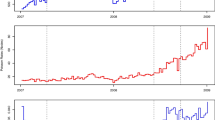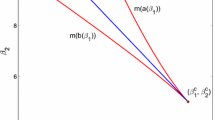Abstract
We analyze a random graph model with preferential attachment rule and edge-step functions that govern the growth rate of the vertex set, and study the effect of these functions on the empirical degree distribution of these random graphs. More specifically, we prove that when the edge-step function f is a monotone regularly varying function at infinity, the degree sequence of graphs associated with it obeys a (generalized) power-law distribution whose exponent belongs to (1, 2] and is related to the index of regular variation of f at infinity whenever said index is greater than \(-1\). When the regular variation index is less than or equal to \(-1\), we show that the empirical degree distribution vanishes for any fixed degree.
Similar content being viewed by others
References
Alves, C., Ribeiro, R., Sanchis, R.: Large communities in a scale-free network. J. Stat. Phys. 166(1), 137–149 (2017)
Alves, C., Ribeiro, R., Sanchis, R.: Agglomeration in a preferential attachment random graph with edge-steps. (2019). Preprint. arxiv:1901.02486
Alves, C., Ribeiro, R., Sanchis, R.: Topological properties of p.a. random graphs with edge-step functions (2019). Preprint. arxiv:1902.10165
Barabási, A.-L., Albert, R.: Emergence of scaling in random networks. Science (1999)
Bingham, N.H., Goldie, C.M., Teugels, J.L.: Regular Variation. Encyclopedia of Mathematics and its Applications, vol. 27. CUP, Cambridge (1989)
Bollobás, B., Riordan, O., Spencer, J., Tusnády, G.: The degree sequence of a scale-free random graph process. Random Struct. Algorithms 18, 279–290 (2001)
Chung, F., Lu, L.: Complex Graphs and Networks (Cbms Regional Conference Series in Mathematics). American Mathematical Society, Boston (2006)
Cooper, C., Frieze, A.: A general model of web graphs. Random Struct. Algorithms 22(3), 311–335 (2003)
Crane, Harry, Dempsey, Walter: Edge exchangeable models for interaction networks. J. Am. Stat. Assoc. 113(523), 1311–1326 (2018)
Deijfen, M., van den Esker, H., van der Hofstad, R., Hooghiemstra, G.: A preferential attachment model with random initial degrees. Arkiv för Matematik 47(1), 41–72 (2009)
Dereich, S., Ortgiese, M.: Robust analysis of preferential attachment models with fitness. Comb. Probab. Comput. 23(3), 386–411 (2014)
Freedman, D.A.: On tail probabilities for martingales. Ann. Probab. 3(1), 100–118 (1975)
Jacob, E., Mörters, P.: Spatial preferential attachment networks: power laws and clustering coefficients. Ann. Appl. Probab. 25(2), 632–662, 04 (2015)
Kim, B., Holme, P.: Growing scale-free networks with tunable clustering. Phys. Rev. E (2002)
Malyshkin, Y., Paquette, E.: The power of choice combined with preferential attachement. Electron. Commun. Probab. 19(44), 1–13 (2014)
Pew Research Center. Social media update 2014 (2014)
Strogatz, S.H., Watts, D.J.: Tcollective dynamics of ’small-world’ networks. Nature (1998)
Thörnblad, E.: Asymptotic degree distribution of a duplication-deletion random graph model. Int. Math. 11, 03 (2014)
Van Der Hofstad, R.: Random graphs and complex networks. Available on http://www.win.tue.nl/rhofstad/NotesRGCN.pdf (2009)
Wang, W.-Q., Zhang, Q.-M., Zhou, T.: Evaluating network models: a likelihood analysis. EPL (Europhysics Letters) 98(2), 28004 (2012)
Acknowledgements
C. A. was supported by the Deutsche Forschungsgemeinschaft (DFG). R. R. was partially supported by Conselho Nacional de Desenvolvimento Científico e Tecnológico (CNPq). R.S. has been partially supported by Conselho Nacional de Desenvolvimento Científico e Tecnológico (CNPq) and by FAPEMIG (Programa Pesquisador Mineiro), Grant PPM 00600/16.
Author information
Authors and Affiliations
Corresponding author
Additional information
Publisher's Note
Springer Nature remains neutral with regard to jurisdictional claims in published maps and institutional affiliations.
Appendices
Appendix A. Important Results on Regularly Varying Functions
In this “Appendix,” we collect some results regarding regularly varying functions that will be useful throughout the paper, as well as providing a proof for an earlier lemma.
Corollary A.1
Let \(\ell \) be a slowly varying function. Then,
Proof
Since \(s^{-1}\ell (s)\) is a RV function which is eventually monotone, we may bound the sum by the integral. Now, by Theorem 1.5.2 of [5], for a fixed small \(\varepsilon \), we know that
uniformly for \(x \in [\varepsilon ,1]\). Therefore, for large enough t
for some small \(\delta \). This proves the desired result. \(\square \)
The three following results are used throughout the paper.
Corollary A.2
(Representation theorem Theorem 1.4.1 of [5]) Let f be a continuous regularly varying function with index of regular variation \(\gamma \). Then, there exists a slowly varying function \(\ell \) such that
for all t in the domain of f.
Corollary A.3
Let f be a continuous regularly varying function with index of regular variation \(\gamma <0\). Then,
as x tends to infinity. Moreover, if \(\ell \) is a slowly varying function, then for every \(\varepsilon >0\)
Proof
Comes as a straightforward application of Theorem 1.3.1 of [5] and Corollary A.2. \(\square \)
Theorem A1
(Karamata’s theorem Proposition 1.5.8 of [5]) Let \(\ell \) be a continuous slowly varying function and locally bounded in \([x_0, \infty )\) for some \(x_0 \ge 0\). Then
-
(a)
for \(\alpha > -1\)
$$\begin{aligned} \int _{x_0}^{x}t^{\alpha }\ell (t)\text {d}t \sim \frac{x^{1+\alpha }\ell (x)}{1+\alpha }. \end{aligned}$$(A.6) -
(b)
for \(\alpha < -1\)
$$\begin{aligned} \int _{x}^{\infty }t^{\alpha }\ell (t)\text {d}t \sim \frac{x^{1+\alpha }\ell (x)}{1+\alpha }. \end{aligned}$$(A.7)
We finish this section with the proof of an earlier lemma.
Proof of Lemma 2
(i) By Potter’s theorem (Theorem 1.5.6 of [5]), if \(\ell \) is slowly varying, then for every \(\delta >0\) there exists \(M>0\) such that
for every \(x,y>M\). We have
We then obtain
by Corollary A.3. Choosing \(\delta <1-\gamma \) in (A.8), we see that
and therefore the LHS of the above equation tends to 0 by the dominated convergence theorem. This and another elementary application of Corollary A.3 finish the proof of item (i).
(ii) We have
since \(\ell (s)s^{-\gamma }\) is eventually monotone decreasing. Dividing both sides by \(t^{1-\gamma }\ell (t)\) and making the substitution \(u=st^{-1}\) in the integral gives the result. \(\square \)
Appendix B. Martingales Concentration Inequalities
For the sake of completeness, we state here two useful concentration inequalities for martingales which are used throughout the paper.
Theorem B1
(Azuma-Höffeding Inequality [7]) Let \((M_n,{\mathcal {F}})_{n \ge 1}\) be a (super)martingale satisfying
Then, for all \(\lambda > 0 \) we have
Theorem B2
(Freedman’s inequality [12]) Let \((M_n, {\mathcal {F}}_n)_{n \ge 1}\) be a (super)martingale. Write
and suppose that \(M_0 = 0\) and
Then, for all \(\lambda > 0 \) we have
Rights and permissions
About this article
Cite this article
Alves, C., Ribeiro, R. & Sanchis, R. Preferential Attachment Random Graphs with Edge-Step Functions. J Theor Probab 34, 438–476 (2021). https://doi.org/10.1007/s10959-019-00959-0
Received:
Revised:
Published:
Issue Date:
DOI: https://doi.org/10.1007/s10959-019-00959-0
Keywords
- Complex networks
- Preferential attachment
- Concentration bounds
- Power-law
- Scale-free
- Karamata’s theory
- Regularly varying functions




